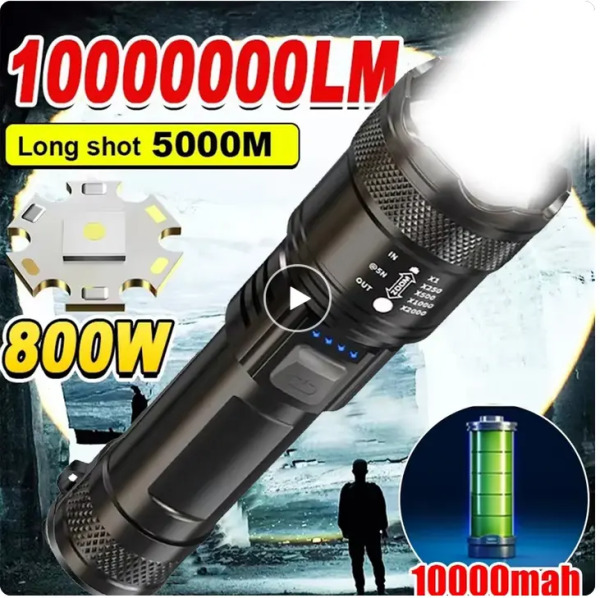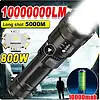Chinese
Let me think out loud about this oriental style advertisement:
So first, it is emitting 10 million lumens, which is about the same as a 650 000 Watt (650 kW) incandescent light. That is 6250 pieces of 100 Watt bulb. It approximately need 112 kW LED emitters if you use common consumer grade ones.
Industry leader tech can emit 140 lm/W, even of those we'd need 71.4 kW (and 150 k pieces of them, which would require 7 m² area (which is about 40×40 bananas [40 square bananas] for USA people).
Before we start to worry about the flashlight of the size of a medium room there is hope: this light uses only 800 Watts instead of 71 kW! Which is truly great Chinese technology, since it means they are using a LED emitter with 12500 lm/W performance! That is an instant Noble prize in physics, chemistry and politics! (Also taking the "industry leader" label, by far.)
So, what battery do we get? It is huge: 10 000 mAh! I mean, it is, well, at least, lots of zeroes.
So, LEDs use, say, 3 V, and the fwd current is about 750mA, and that gives us almost 3 watts. 800 Watts require 266 A, which is 266000 mA, so our battery will go flat in two minutes an 15 seconds.
If they somehow mistaken that and the original wattage stands, 71.4 kW requires about 23800 A, which will empty the battery in 1.57 seconds. It is still great runtime, since you'll go blind in about the same time. Anyway.
Maybe a small but not unimportant problem is that drawing 266 ampers would probably explode the battery in a few seconds, and 28kA, well, it's probably the same as shorting it and watch the fireworks.
...which is probably not a problem, since generating the required light generates about 50 kW heat, which is about 100 times the power of a mobile room heater, or phrasing it another way, the LEDs will burn and explode in probably less than a second, much sooner than the battery would explode, depite that the "LED" is room sized.
So, for $30 it's a pretty good deal. I mean, if you're a soldier, for example, you can use it as an incendiary grenade. A room sized one, but battery driven! (And it can also charge your phone between destructions.)
If you're not then it's good for some Nobel prizes, or getting the campfire started, or possibly also the near forest.
One thing it's not good for, unfortunately: you cannot use it as a flashlight.
(Image is involuntary courtesy of Aliexpress.)
like this
ST20 (backup) and ★ Pope Catweazle Miller like this.
grin reshared this.


ST20 (backup)
•grin ✅
•LLM sez:
So, for a 10 million lumen flashlight:
...we can make a rough estimate by assuming a typical efficiency of around 15 lumens per watt on visible light spectral distribution.
Power (watts) = Lumens / Efficiency = 10,000,000 lumens / 15 lumens/watt ≈ 666 667 watts
Now, to calculate the power density on the skin, we need to consider the area illuminated:
Area = π * radius² = π * (0.5 m)² ≈ 0.785 m²
Power Density = Power / Area ≈ 666 667 watts / 0.785 m² ≈ 849_488 watts/m²
On a clear day, the intensity of sunlight at Earth's surface is around 1000 watts/m².
So, this flashlight is nearly 900 times more intense than sunlight.
The nature of the burn it causes would be similar to a severe thermal burn. The skin would rapidly heat up, causing tissue damage and potentially leading to blistering, charring, and even deeper tissue damage. The speed of the burn would depend on the duration of exposure and the specific properties of the skin. However, it's likely that the
... show moreLLM sez:
So, for a 10 million lumen flashlight:
...we can make a rough estimate by assuming a typical efficiency of around 15 lumens per watt on visible light spectral distribution.
Power (watts) = Lumens / Efficiency = 10,000,000 lumens / 15 lumens/watt ≈ 666 667 watts
Now, to calculate the power density on the skin, we need to consider the area illuminated:
Area = π * radius² = π * (0.5 m)² ≈ 0.785 m²
Power Density = Power / Area ≈ 666 667 watts / 0.785 m² ≈ 849_488 watts/m²
On a clear day, the intensity of sunlight at Earth's surface is around 1000 watts/m².
So, this flashlight is nearly 900 times more intense than sunlight.
The nature of the burn it causes would be similar to a severe thermal burn. The skin would rapidly heat up, causing tissue damage and potentially leading to blistering, charring, and even deeper tissue damage. The speed of the burn would depend on the duration of exposure and the specific properties of the skin. However, it's likely that the damage would occur very quickly, potentially within seconds.
High-power lasers can achieve power densities of millions of watts per square centimeter, which is orders of magnitude higher than our flashlight. However, lasers focus their energy into a tiny spot, making them extremely dangerous. Our flashlight, while still incredibly powerful, spreads its energy over a larger area.
ST20 (backup)
•grin ✅ likes this.
grin ✅
•I have tried to play with LLM (Google Gemini) to provide me the battery pack required, and it would consist about 1000 pieces of 18650, plus probably about the same amount providing power to cooling and battery management. That is just for the current drawn, the runtime would be still seconds, mainly due to the batteries losing voltage and going flat.
For a 1 hour runtime we'd need 267 kg of LiPo battery, if we assume 50 grams per battery.
We might need a mighty big flashlight handle, and some significant thermal insulation. 😀
ST20 (backup)
•